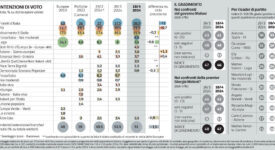(Il testo seguente è tratto integralmente dalla nota inviata all’Agenzia Opinione) –
///

Detections in Central Mediterranean tripled in the first 3 months of 2023. In the first three months of 2023, the number of irregular border crossings reported by national authorities increased to 54 000, 26% more than in the same period last year. The Central Mediterranean and Western Balkan routes remain the most active.
In March, more than 22 500 irregular border crossings were detected at EU’s external borders*, 60% more than a year ago.
More than 2 400 standing corps officers and Frontex staff are taking part in operational activities protecting EU’s external borders and supporting EU member states and neighbouring countries facing various challenges at the external borders.
Key developments
54 000 irregular border crossings detected in the first three months of 2023
Central Mediterranean route accounts for more than half of all irregular border crossings into the EU
Nationals of Syria, Cote dÍvoire and Guinea account for the largest number of detections

Top migratory routes
The Central Mediterranean was the most active route in the first quarter of the year with nearly 28 000 irregular border crossings, three times the number from a year ago. In March, the total detections on this route increased almost nine-fold compared to last year to more than 13 000.
Organised crime groups took advantage of better weather and political volatility in some countries of departure to try to smuggle as many migrants as possible across the Central Mediterranean from Tunisia and Libya.
Western Balkans remains the second most active migratory route with nearly 15 000 detections, although it continues to see smaller numbers than a year ago. The decline can be attributed to the visa-policy alignments in the region with the EU and the reinforcement of border control capacities by Hungary.
The number of irregular crossings in the English Channel towards the UK in the first quarter fell 15% from a year ago to 7 400 (detections on both sides of the Channel). This temporary decrease can be attributed to unfavourable sea condition.
Note: The preliminary data presented in this statement refer to the number of detections of irregular border-crossing at the external borders of the European Union. The same person may cross the border several times in different locations at the external border.

///
TRADUZIONE DA “GOOGLE TRANSLATION” (è possibile che il testo in lingua straniera non sia tradotto in maniera ottimale, si raccomanda di verificare l’esatto contenuto-traduzione)
I rilevamenti nel Mediterraneo centrale sono triplicati nei primi 3 mesi del 2023. Nei primi tre mesi del 2023, il numero di attraversamenti irregolari delle frontiere segnalati dalle autorità nazionali è aumentato a 54.000, il 26% in più rispetto allo stesso periodo dell’anno scorso. Le rotte del Mediterraneo centrale e dei Balcani occidentali restano le più attive.
A marzo, sono stati rilevati più di 22 500 attraversamenti irregolari alle frontiere esterne dell’UE*, il 60% in più rispetto a un anno fa.
Più di 2 400 ufficiali del corpo permanente e personale di Frontex stanno prendendo parte ad attività operative per proteggere le frontiere esterne dell’UE e sostenere gli Stati membri dell’UE e i paesi limitrofi che affrontano varie sfide alle frontiere esterne.
Sviluppi chiave
54.000 attraversamenti irregolari delle frontiere rilevati nei primi tre mesi del 2023
La rotta del Mediterraneo centrale rappresenta oltre la metà di tutti gli attraversamenti irregolari delle frontiere verso l’UE
I cittadini di Siria, Costa d’Avorio e Guinea rappresentano il maggior numero di rilevamenti
Principali rotte migratorie
Il Mediterraneo centrale è stata la rotta più attiva nel primo trimestre dell’anno con quasi 28 000 attraversamenti irregolari delle frontiere, il triplo rispetto a un anno fa. A marzo, i rilevamenti totali su questa rotta sono aumentati di quasi nove volte rispetto allo scorso anno, superando i 13.000.
I gruppi della criminalità organizzata hanno approfittato del clima migliore e della volatilità politica in alcuni paesi di partenza per cercare di contrabbandare il maggior numero possibile di migranti attraverso il Mediterraneo centrale dalla Tunisia e dalla Libia.
I Balcani occidentali rimangono la seconda rotta migratoria più attiva con quasi 15 000 rilevamenti, sebbene continuino a registrare numeri inferiori rispetto a un anno fa. Il calo può essere attribuito agli allineamenti della politica dei visti nella regione con l’UE e al rafforzamento delle capacità di controllo delle frontiere da parte dell’Ungheria.
Il numero di attraversamenti irregolari nella Manica verso il Regno Unito nel primo trimestre è sceso del 15% rispetto a un anno fa a 7 400 (rilevamenti su entrambe le sponde della Manica). Questa diminuzione temporanea può essere attribuita alle sfavorevoli condizioni del mare.
Nota: i dati preliminari presentati in questa dichiarazione si riferiscono al numero di rilevamenti di attraversamento irregolare delle frontiere alle frontiere esterne dell’Unione europea. La stessa persona può attraversare la frontiera più volte in luoghi diversi alla frontiera esterna.
*The figure includes other less active migratory routes not mentioned in this press release. The final figures may be higher due to delayed reporting.
** Note: You are receiving this email because you are in our database of journalists who have expressed interest in Frontex activities. If you would like to stop receiving news from Frontex, please contact us at: press@frontex.europa.eu.







